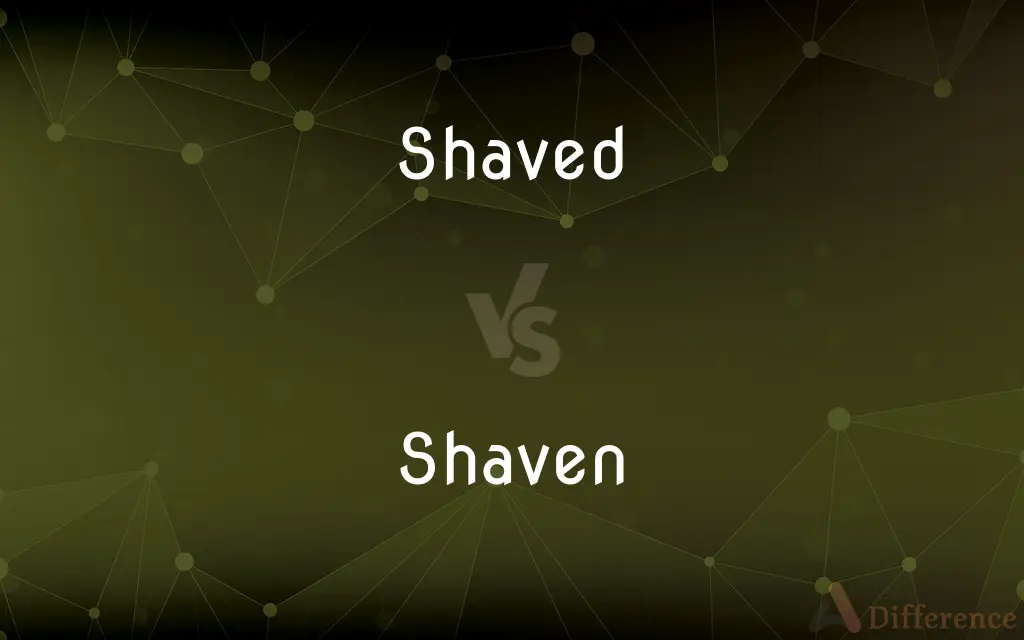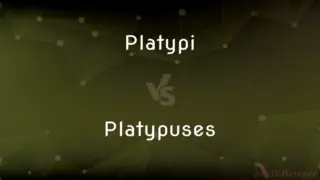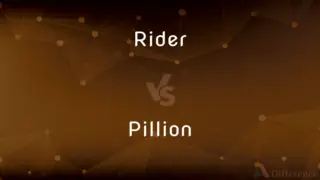Shaved vs. Shaven — What's the Difference?
Edited by Tayyaba Rehman — By Fiza Rafique — Updated on April 1, 2024
Shaved refers to the action of removing hair with a razor or similar tool, typically leaving a smooth surface, while shaven often implies that the shaving occurred in the past and may not be as smooth over time.

Difference Between Shaved and Shaven
Table of Contents
ADVERTISEMENT
Key Differences
Shaved is commonly used to describe the act of removing hair at the moment or in a recent context, focusing on the process itself. It suggests a current or ongoing action, emphasizing the immediacy of the hair removal. On the other hand, shaven is usually employed to describe a state or condition resulting from having shaved, often used in a past or completed context, implying that the action of shaving has already occurred.
While "shaved" implies a certain freshness or recentness to the act, indicating that the skin or shaved area might still be very smooth, shaven might suggest that some time has passed since the shaving occurred, and the smoothness could be lessening. Whereas "shaved" is active, highlighting the direct action, "shaven" is more passive, focusing on the outcome or result of the action.
In terms of usage, "shaved" is often found in more casual or everyday contexts, such as describing daily grooming routines. It's straightforward and directly references the action taken. On the other hand, "shaven" carries a slightly more formal or literary tone, often found in written descriptions or narratives that reflect on a past state or action.
Grammatically, "shaved" functions as both the simple past tense and the past participle of the verb "to shave," depending on the sentence structure. This dual role allows it to fit into a variety of sentences seamlessly. Shaven, however, is exclusively used as the past participle and is typically accompanied by auxiliary verbs to denote the perfect aspect or passive voice.
The choice between "shaved" and "shaven" can also reflect regional or dialectal preferences in English. Some English-speaking regions may predominantly use "shaved" for both the past action and the resultant state, while others might prefer "shaven" for its nuanced implication of a past completed action, especially in more formal or traditional contexts.
ADVERTISEMENT
Comparison Chart
Part of Speech
Verb (past tense/past participle)
Past participle only
Implication of Timing
Recent or current
Past or completed
Usage Context
More casual, everyday
More formal, literary
Tone
Direct, straightforward
Slightly more formal or nuanced
Example Sentence
"He shaved his beard yesterday."
"His face was smoothly shaven."
Compare with Definitions
Shaved
Trimmed closely.
She shaved the edges of the paper for the art project.
Shaven
Implies a clean, hairless state.
He preferred a shaven look for professional meetings.
Shaved
Made smooth by cutting.
The barber shaved his head clean.
Shaven
Suggests removal of hair or surface layer.
The sculpture's shaven stone surface was smooth to touch.
Shaved
Removed hair with a razor or similar tool.
She shaved her legs for the swimming competition.
Shaven
Having had hair removed in the past.
His shaven chin felt rough by evening.
Shaved
Cut off closely to the skin.
He shaved the wood smoothly with a knife.
Shaven
Describes a smoothly cut surface.
The shaven ice glistened in the sun.
Shaved
Removed surface layer.
The chef shaved chocolate on the cake.
Shaven
Indicates a past action of shaving.
The shaven areas were now showing stubble.
Shaved
To remove the beard or other body hair from, with a razor or shaver
The barber lathered his face and then shaved him.
Shaven
Having the beard or hair cut off close to the skin
Shaved
To cut (the beard, for example) at the surface of the skin with a razor or shaver.
Shaven
Shaved
A boy with a shaven head
Shaved
To crop, trim, or mow closely
Shave a meadow.
Shaven
To remove the beard or other body hair from, with a razor or shaver
The barber lathered his face and then shaved him.
Shaved
To remove thin slices from
Shave a board.
Shaven
To cut (the beard, for example) at the surface of the skin with a razor or shaver.
Shaved
To cut or scrape into thin slices; shred
Shave chocolate.
Shaven
To crop, trim, or mow closely
Shave a meadow.
Shaved
To come close to or graze in passing.
Shaven
To remove thin slices from
Shave a board.
Shaved
Simple past tense and past participle of shave
Shaven
To cut or scrape into thin slices; shred
Shave chocolate.
Shaved
Having the beard or hair cut off close to the skin
Shaven
To come close to or graze in passing.
Shaven
Having been shaved.
Shaven
Past participle of shave
Common Curiosities
What does "shaved" imply?
Shaved implies the recent or current removal of hair, focusing on the action itself.
Does the use of "shaved" or "shaven" vary by English dialect?
Yes, the preference for "shaved" or "shaven" can vary regionally and by dialect.
What does "shaven" imply?
Shaven implies that the shaving occurred in the past, often suggesting a certain lapse of time since the action.
Can "shaved" refer to things other than hair removal?
Yes, "shaved" can also describe making something smooth or trimming closely, not just hair removal.
Can "shaved" and "shaven" be used interchangeably?
While they can sometimes be used interchangeably, "shaved" is better for recent actions, and "shaven" for past or completed states.
Is "shaven" only used for facial hair?
No, "shaven" can refer to the removal of hair from any part of the body or to the smoothness of other surfaces.
Is "shaven" more formal than "shaved"?
Yes, "shaven" tends to carry a slightly more formal or literary tone compared to "shaved."
How does the choice between "shaved" and "shaven" affect the tone of a sentence?
"Shaved" creates a more direct and straightforward tone, while "shaven" can introduce a more nuanced or reflective quality.
Which is grammatically correct: "He has shaved" or "He is shaven"?
Both are grammatically correct but convey different aspects: "He has shaved" focuses on the action, while "He is shaven" describes his state.
What is the past participle of "to shave"?
Both "shaved" and "shaven" serve as the past participle, but "shaven" is used exclusively in this role.
Share Your Discovery

Previous Comparison
Platypi vs. Platypuses
Next Comparison
Rider vs. PillionAuthor Spotlight
Written by
Fiza RafiqueFiza Rafique is a skilled content writer at AskDifference.com, where she meticulously refines and enhances written pieces. Drawing from her vast editorial expertise, Fiza ensures clarity, accuracy, and precision in every article. Passionate about language, she continually seeks to elevate the quality of content for readers worldwide.
Edited by
Tayyaba RehmanTayyaba Rehman is a distinguished writer, currently serving as a primary contributor to askdifference.com. As a researcher in semantics and etymology, Tayyaba's passion for the complexity of languages and their distinctions has found a perfect home on the platform. Tayyaba delves into the intricacies of language, distinguishing between commonly confused words and phrases, thereby providing clarity for readers worldwide.















































